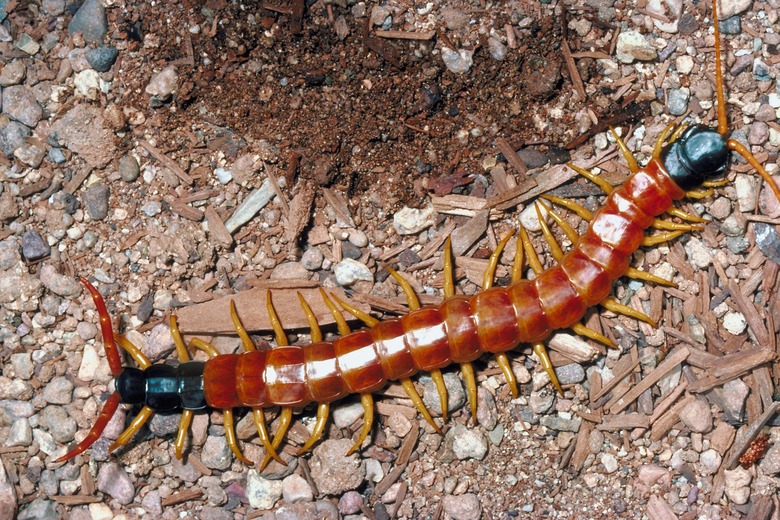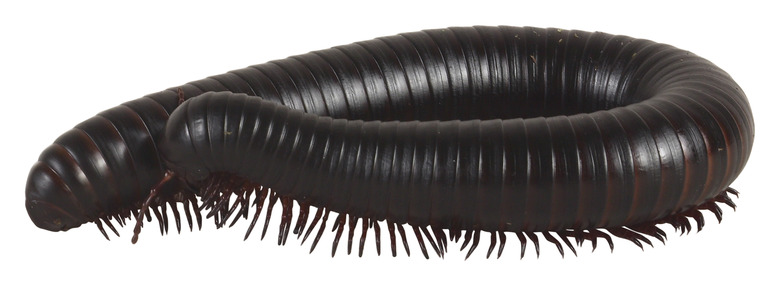The Characteristics Of Centipedes
Centipedes are crawlers with one pair of legs per body segment. Most are more likely to have about 30 pairs of legs rather than 100. Though they have a venomous bite, the rare bite to a human seldom results in serious injury. In the garden, they are beneficial because they control pests.
Legs
Legs
There are 3,000 species of centipedes, according to the "Firefly Encyclopedia of Insects and Spiders." All centipedes have at least 15 body segments with a pair of legs on each. Most are fast runners. The number of body segments is never an even number. Some centipedes are long and very thin with 27 to 191 pairs of short legs. Others are broader with exactly 15 pairs or 21 to 23 pairs of legs, and centipedes never put all their legs on the ground simultaneously.
Habitat
Habitat
Many centipedes live in dark, damp places. Commonly, they dwell in cracks and under logs, fallen leaves and rocks. Others live in the soil. The common house centipede dwells inside and outside of homes and buildings. Inside centipedes often dwell near insects and in bathrooms, basements, closets and other moist places. They avoid light and come out at night to eat.
Prey
Prey
As carnivores, centipedes eat insects, worms, snails, spiders and other creatures living around them. They sometimes feed on carcasses. All centipedes have three mouth parts. House centipedes eat cockroaches, flies and other pests.
Venom and Other Protections
Venom and Other Protections
Centipedes have a pair of venomous claws where their first pair of legs would be. After dosing their victims with venom, they eat them. Humans, of course, are not their prey. Only the venom of certain large centipedes can injure humans. Bites might occur when humans try to pick up or crush centipedes, according to the article "Millipedes, Centipedes and Sowbugs" by W. S. Cranshaw. Minor discomfort sometimes follows, although cases of tissue damage have been reported. Some centipedes protect themselves from predators by secreting a sticky toxin. Others secrete sticky threads that can be used to wrap up a predator. Others confuse would-be predators by separating from their bodies and wiggling, according to the" Firefly Enclclopedia."
Benefits Outdoors
Benefits Outdoors
Since centipedes eat garden pests, the Agriculture and Natural Resources Department of the University of California recommends never trying to get rid of them outdoors.
Reproduction
Reproduction
The females of some species have live births. In some species, the male puts sperm on a web he has made from where the female retrieves the sperm. In other species, the male deposits 150 to 450 packets of sperm on long stalks, notes the "Firefly Encyclopedia." The female eats about 18 packets daily, keeping some of the sperm in an enclosure in her mouth. Before she lays her eggs she puts them in her mouth to put sperm on them.
References
- University of California, Agriculture and Natural Resources; Millipedes and Centipedes; March 2000
- "Firefly Enclyclopedia of Insects and Spiders;" Christopher O'Toole, editor; 2002
- Iowa State University, Department of Entomology: House Centipede
Cite This Article
MLA
Riggins, Linda Nele. "The Characteristics Of Centipedes" sciencing.com, https://www.sciencing.com/the-characteristics-of-centipedes-12586273/. 12 August 2011.
APA
Riggins, Linda Nele. (2011, August 12). The Characteristics Of Centipedes. sciencing.com. Retrieved from https://www.sciencing.com/the-characteristics-of-centipedes-12586273/
Chicago
Riggins, Linda Nele. The Characteristics Of Centipedes last modified March 24, 2022. https://www.sciencing.com/the-characteristics-of-centipedes-12586273/

